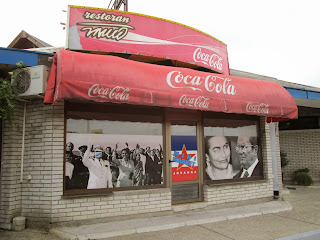 |
| The billboard looks a bit tired but the restaurant Tito is fully functional and alive with customers. |
Josip Broz Tito (1892-1980) from 1953 up until his death was the leader of the Socialist Yugoslavia, a federal country that included today's Serbia, Croatia, Bosnia & Herzegovina, Slovenia, Macedonia, Montenegro and Kosovo *.
* Socialist Bulgaria was also thinking about joining the Tito's federation in the early days of the doctrine and, because of this, got into serious trouble with Stalin. Bulgaria's leader Georgi Dimitrov was invited to Moscow and suddenly died there in 1949.
Although an authoritarian, Tito was loved by many and nicknamed a well-meaning 'father'. He did impose sanctions on his political opponents but the mainstream opinion was that Tito was a 'true' leader, keeping the interests of the federation's people above their nationalities.
Of all socialist republics during the Cold War Yugoslavia was among the most 'sane', and it kept itself separately from Stalin who dominated most of the socialist Eastern Europe. In fact, as I have already mentioned in an earlier post, the Yugoslav passport was highly desired not only by fellow socialists of the time but by many capitalist citizens too, as it was one of the few passports allowing its owner free travel nearly everywhere in the world.
Even now, 33 years after his death and 21 years after the disintegration of the socialist Yugoslavia, Tito is well-respected and even missed by some Serbs.
It is 2013. I am hitch-hiking from Belgrade to Niš. A Serbian driver, seemingly in his 40s, offers to stop for a coffee at a roadside restaurant. The place is called 'Tito'.
It looks like a little shrine, or a museum, or a memorial to the great leader and the socialist times. Both inside and outside there are busts, portraits, maps, newspaper clippings, ideological books. Groups of customers sit here and there at a few tables, chatting in what sounds like Serbo-Croatian. It is only a weekday afternoon, there are no large cities nearby. I can estimate that perhaps well over a hundred people could be seated on the premises if need be.
Next to the restaurant there is a mini market 'Jovanka', named after Tito's last wife. You get to visit the whole complex.
Even if some of the outside posters & photos seem to be deliberately damaged by those who do not miss the old days, the restaurant does not seem to have problems finding a sufficient number of customers, my hospitable driver including.
 |
| Mini market Jovanka, some of its exterior photos damaged by those who do not miss the old times. |
You have now read the post. If you have an arhaeological interest, here is what you can do next:
- Watch the film 'Good Bye Lenin!' about an East Germany woman who falls into coma during the socialist times and wakes up in a whole new era;
- Visit the Grūtas Park in Lithuania. After separating from the Soviet Union, Lithuanians decided to move all their marxes, lenins, stalins and other communist decorations into a specially-designated theme park, now a popular tourist attraction.
Text and photos (c) Agne Drumelyte, 2013.








































